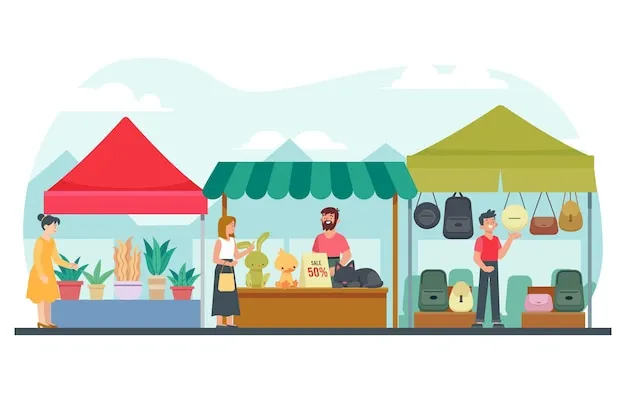The Free Market
Introduction
There is an important distinction between the market and the economy. The former is essentially the latter out from under the overbearing weight of politics and government. There is an inherent skepticism that comes with unregulated entities such as the free market. Why is that the case? I think people tend to fear things that they do not understand because it is easier to brush aside than to put in the work to educate yourself. When people here free market they have some idea of dark web exchanges and a world that will eventually devolve into chaos; a view born out of ignorance. A free market allows unbridled competition which serves to directly benefit the consumer, so society as a whole would be better off.
Free Exchange
Fundamental to the market is the idea of free exchange. A free exchange is when any two people swap goods or services. If two people come together and agree to make the transaction, then they should be allowed to do so. If both parties were not better off, they would not enter into this agreement. In that sense, a free exchange maximizes the net positive, assuming there are no nefarious actions being taken by either party. The main goal of the entrepreneur is to identify a product or service that allows them to enter in many free exchanges to make a profit. Simply put, the entrepreneur values the capital he is paid more than the product he sells. Bylund says, “the economy is people acting and interacting… it is how we act to satisfy our wants, to make us better off” (p. 15-16, 2022). Every transaction an entrepreneur enters is an exchange where both parties leave better than they came. The free exchange is a valuable utilitarian tool central to the concept of a free market and is imperative for unbridled entrepreneurship. Restrictions suppress innovation and the consumer suffers as a consequence.
Economic Cost
Entrepreneurship can be risky because of how quickly things change. If someone puts a lot of resources and capital into making a product that takes weeks to produce, there is no guarantee that it will be relevant once it is finished. Bylund talks about this phenomenon and how time becomes an important production factor (pp. 8-9, 2016). Any time someone puts resources toward something there is an economic cost that is unseen which is the value those specific resources could have generated had they been used in a different manner. Obviously there is no going back once production has begun, but the best entrepreneurs attempt to minimize this economic cost through careful choices. Bylund sums up the internal dialogue of the entrepreneur with, “We know that actions are directed toward attaining something—some outcome—that the actor considers beneficial. In other words, actions are intended to achieve something the actor personally values” (p. 23, 2022). It is impossible to predict the future but it is possible to prevent over-leveraging in production and remain flexible to be ready to adapt when the time comes.
Disruptive Innovation
Entrepreneurship is laced with uncertainty. It is often those that respond to the unexpected with a positive attitude that find success. One way to harness the unexpected is to think outside of the box in an effort to break into a market with a product that changes how something is done or thought about. This “disruptive innovation” revolutionizes the norm of a given industry and sets the standard for future entrepreneurs to reach or exceed. This is a powerful tool for entrepreneurs to harness, but it is also something they must compete against. Bylund stated, “Business do not only compete with existing businesses, but also compete with businesses that do not exist yet” (p. 45, 2022). The ability for a competitor to crop up and change the game at any moment requires constant vigilance and renewed innovation; both qualities that drive the market forward and manifest as lower prices, more options, and increased advancements to the consumer. In his work “The Seen, the Unseen, and the Unrealized”, Bylund goes so far as to state, “entrepreneurs can, through disruptive products, educate consumers about their own wants, which until that point remained ‘hidden’ and latent—even to themselves.” (p. 11, 2016). This quote shows the power the entrepreneur has to change lives by introducing something so revolutionary that consumers didn’t even realize what they were missing out on. The free market encourages this kind of innovation and provides the opportunity for brilliance through unhindered competition.
Conclusion
The free market is like a playground for entrepreneurs. Having the ability to compete for business allows the truly best product to win out, which only serves to increase quality overall. Innovation runs rampant in a free market and individuals are free to enter any exchange they so please which makes society better as a whole. Although we may never see a pure free market, I think a lot of the ideas and reasons behind it can be implemented to loosen restrictions and increase quality of life for consumers. Doing away with things like tariffs and embargoes would allow people to trade more freely with other countries and also may open doors due to freed up resources from domestic companies. It would be interesting to see the impact just a few free market policies on our current economy.
References
Bylund, P. L. (2016). Chapter 1: The How of the Market. In Seen, the unseen, and the unrealized: How regulations affect our everyday lives (pp. 1–14). essay, Lexington Books.
Bylund, P. L. (2022). Chapter 1: What Economics Is. In How to Think About the Economy: A Primer (pp. 15–20). essay, Mises Institute.
Bylund, P. L. (2022). Chapter 2: Economic Theory. In How to Think About the Economy: A Primer (pp. 21–26). essay, Mises Institute.
Bylund, P. L. (2022). Chapter 4: A Process, Not a Factory. In How to Think About the Economy: A Primer (pp. 41–50). essay, Mises Institute.
